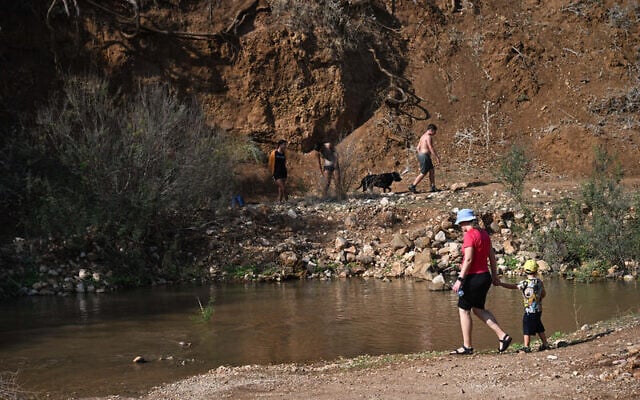Texas Voters Approve Billions for Water Systems – Governing

Report on Texas’s New Water Fund and its Alignment with Sustainable Development Goals
Executive Summary
In response to escalating water scarcity, aging infrastructure, and population growth, Texas voters have approved a constitutional amendment establishing the Texas Water Fund. This initiative dedicates $1 billion annually for two decades to finance critical water projects. The fund represents a significant state-level commitment to achieving key United Nations Sustainable Development Goals (SDGs), particularly SDG 6 (Clean Water and Sanitation), SDG 9 (Industry, Innovation and Infrastructure), SDG 11 (Sustainable Cities and Communities), and SDG 13 (Climate Action).
State of Water Resources in Texas: A Challenge to Sustainability
Current Pressures on Water Systems
Texas faces a convergence of challenges that threaten its water security and impede progress toward the SDGs. Projections from the Texas Water Development Board indicate that without substantial intervention, municipal water shortages could increase fifteen-fold by 2070, resulting in an estimated $153 billion in economic damages. These pressures are a direct threat to sustainable development.
- Climate Change and Drought: Extended drought conditions, exacerbated by climate change, have led to unprecedented water shortages. Natural resources like Jacob’s Well and Las Moras Springs, vital to local ecosystems (SDG 15), are drying up with increasing frequency. This directly challenges the state’s resilience and adaptive capacity (SDG 13).
- Infrastructure Deficit: Much of the state’s water transport and treatment infrastructure is decades old and inefficient. An estimated 186 billion gallons of water are lost annually to leaks alone, undermining efforts for responsible consumption and production (SDG 12) and efficient water management (SDG 6).
- Demographic and Economic Pressures: Rapid population growth, particularly in rural and Hill Country areas, places immense strain on existing water systems. Rural communities often lack the tax base to fund necessary upgrades, creating disparities in access to essential services (SDG 11).
The Texas Water Fund: A Framework for Achieving the SDGs
Strategic Allocation and Financial Mechanisms
The newly established Texas Water Fund, approved as Proposition 4, provides a dedicated, long-term funding stream to address these challenges. Its structure is designed to promote equity and sustainability, directly supporting the implementation of the SDGs at a local level.
- Financial Accessibility for Disadvantaged Communities: The fund will offer low-interest and forgivable loans, ensuring that smaller, rural water systems can undertake critical infrastructure projects without imposing prohibitive costs on residents. This mechanism is crucial for achieving universal and equitable access to safe and affordable drinking water (SDG 6.1).
- Bridging the Funding Gap: The initiative addresses a significant shortfall in existing funding programs. In 2025, the Texas Drinking Water State Revolving Fund faced a funding gap of approximately $4 billion, leaving hundreds of communities without assistance. The new fund will help close this gap, accelerating progress on infrastructure development (SDG 9).
- Protection of Water Resources: The legislation explicitly prohibits the use of funds for the transport of fresh groundwater from rural to urban areas, safeguarding local water sources and ecosystems (SDG 15).
Direct Contributions to Sustainable Development Goals
- SDG 6: Clean Water and Sanitation: The fund’s primary objective is to ensure the availability and sustainable management of water. By repairing leaky pipes, upgrading treatment facilities, and securing new water sources, the initiative directly advances targets for water-use efficiency (6.4) and integrated water resources management (6.5).
- SDG 9: Industry, Innovation and Infrastructure: The investment focuses on developing quality, reliable, and resilient water infrastructure. This is fundamental to supporting economic development, human well-being, and equitable access for all, particularly in rural regions.
- SDG 11: Sustainable Cities and Communities: By ensuring a stable supply of water, the fund makes communities more resilient and sustainable. It addresses a basic service essential for safe and adequate housing and protects communities from the economic and social impacts of water-related disasters like drought (11.5).
- SDG 13: Climate Action: The fund strengthens resilience and adaptive capacity to climate-related hazards. Projects such as aquifer storage and recovery (ASR) in Kerrville allow communities to store water during times of surplus and use it during droughts, demonstrating a clear strategy for climate adaptation (13.1).
Conclusion: A Model for Long-Term Water Resilience
The approval of the Texas Water Fund is a landmark step in aligning state policy with global sustainability targets. By investing in modern infrastructure, promoting conservation, and ensuring equitable access for its most vulnerable communities, Texas is building a foundation for a water-secure future. This initiative serves as a comprehensive strategy to mitigate the impacts of climate change, protect vital ecosystems, and ensure that clean water remains a catalyst for sustainable development across the state.
Analysis of Sustainable Development Goals in the Article
1. Which SDGs are addressed or connected to the issues highlighted in the article?
The article on Texas’s new water fund addresses several interconnected Sustainable Development Goals (SDGs) by focusing on water security, infrastructure resilience, and community sustainability in the face of environmental challenges.
-
SDG 6: Clean Water and Sanitation
- This is the most central SDG to the article. The entire piece discusses the challenges of dwindling water supply, the need for safe and sustainable water management, and the financial mechanisms being put in place to ensure water availability for all communities, particularly rural ones.
-
SDG 9: Industry, Innovation and Infrastructure
- The article heavily emphasizes the state of Texas’s water infrastructure. It highlights that the “current state infrastructure is aging” and “decades old and insufficient in its capacity.” The $1 billion annual fund is a direct investment in developing reliable, sustainable, and resilient infrastructure to support both communities and economic activities.
-
SDG 11: Sustainable Cities and Communities
- The initiative aims to make communities, especially “small, rural water systems,” more sustainable and resilient. The article notes that without intervention, these communities face significant water risks. By providing funding for infrastructure improvements, the state is working to ensure these communities remain viable and secure in the face of population growth and water scarcity.
-
SDG 13: Climate Action
- The article explicitly links the water crisis to climate-related hazards, stating the initiative is aimed at bracing the state for “future drought risk” and mentioning “extended drought” as a key factor. The infrastructure projects, such as aquifer storage and recovery, are adaptive measures designed to strengthen resilience against the impacts of climate change.
2. What specific targets under those SDGs can be identified based on the article’s content?
Based on the issues and solutions presented, several specific SDG targets can be identified:
-
Under SDG 6 (Clean Water and Sanitation):
- Target 6.1: “By 2030, achieve universal and equitable access to safe and affordable drinking water for all.” The article addresses this by focusing on funding for rural and “disadvantaged” communities that lack the tax base for necessary improvements, using low-interest and forgivable loans to make projects affordable.
- Target 6.4: “By 2030, substantially increase water-use efficiency across all sectors and ensure sustainable withdrawals and supply of freshwater to address water scarcity…” This is directly relevant to the mention of Texas losing “186 billion gallons of water annually from leaks in pipes alone.” Fixing these leaks is a primary goal of the infrastructure funding. Furthermore, projects like “aquifer storage and recovery” are designed to ensure a sustainable supply during droughts.
- Target 6.a: “By 2030, expand… capacity-building support… in water- and sanitation-related activities and programmes.” The Texas Water Fund, managed by the Texas Water Development Board, acts as a state-level mechanism to provide financial and capacity-building support to smaller communities that cannot fund these projects on their own.
-
Under SDG 9 (Industry, Innovation and Infrastructure):
- Target 9.1: “Develop quality, reliable, sustainable and resilient infrastructure… to support economic development and human well-being, with a focus on affordable and equitable access for all.” The core purpose of the $1 billion fund is to “fix failing systems” and build resilient water infrastructure that can withstand future droughts, thereby supporting the well-being of Texans and preventing economic losses.
-
Under SDG 11 (Sustainable Cities and Communities):
- Target 11.5: “By 2030, significantly reduce… the direct economic losses relative to global gross domestic product caused by disasters, including water-related disasters…” The article cites a projection that water shortages could create “$153 billion in economic damages” by 2070. The infrastructure initiative is a direct attempt to mitigate these future economic losses from the slow-onset disaster of drought and water scarcity.
-
Under SDG 13 (Climate Action):
- Target 13.1: “Strengthen resilience and adaptive capacity to climate-related hazards and natural disasters in all countries.” The article frames the entire initiative as a response to “future drought risk” and “extended drought.” The funding for projects like aquifer storage and pipe repair directly enhances the state’s adaptive capacity to the increasing frequency and severity of droughts, which are climate-related hazards.
3. Are there any indicators mentioned or implied in the article that can be used to measure progress towards the identified targets?
Yes, the article mentions several quantitative and qualitative indicators that can be used to measure progress:
-
Financial Investment as an Indicator:
- The primary indicator of commitment is the allocation of “$1 billion annually for the next 20 years” to the Texas Water Fund. Tracking the disbursement and use of these funds is a direct measure of action.
-
Indicator of Water-Use Efficiency:
- The article provides a baseline for water loss: “186 billion gallons of water annually from leaks in pipes alone.” A key indicator of progress towards Target 6.4 would be a measured reduction in this volume over time as infrastructure is repaired.
-
Indicators of Water Scarcity and Risk:
- The Texas Water Development Board’s projection of a “3.1 million acre-feet” water shortage by 2070 serves as a benchmark. Progress can be measured by revised projections showing a reduction in this expected shortage.
- The projected “$153 billion in economic damages” is another baseline. Successful implementation of the water plan should lead to a reduction in this projected economic risk.
-
Indicator of Infrastructure Funding Gap:
- The article highlights a significant funding gap, noting that in 2025, there was a “shortfall of roughly $4 billion” with “355 projects” seeking funds but only “31 projects” invited to apply. An indicator of success would be the reduction of this gap and an increase in the number of critical projects funded annually through the new Texas Water Fund.
-
Indicator of Technological Adaptation:
- The implementation of specific projects like “aquifer storage and recovery” systems is a qualitative and quantitative indicator. The number of such systems built and their capacity to store water can be tracked to measure progress in building resilience (Target 13.1).
4. Table of SDGs, Targets, and Indicators
| SDGs | Targets | Indicators |
|---|---|---|
| SDG 6: Clean Water and Sanitation |
|
|
| SDG 9: Industry, Innovation and Infrastructure |
|
|
| SDG 11: Sustainable Cities and Communities |
|
|
| SDG 13: Climate Action |
|
|
Source: governing.com
What is Your Reaction?
 Like
0
Like
0
 Dislike
0
Dislike
0
 Love
0
Love
0
 Funny
0
Funny
0
 Angry
0
Angry
0
 Sad
0
Sad
0
 Wow
0
Wow
0




















































.jpg.webp?itok=0ZsAnae9#)



























